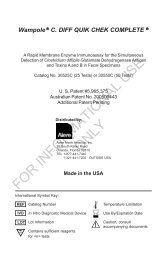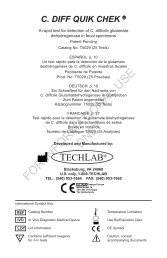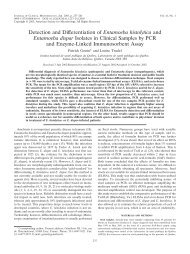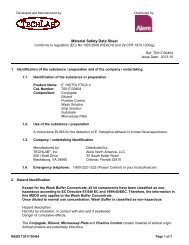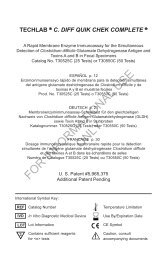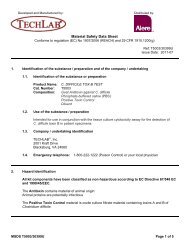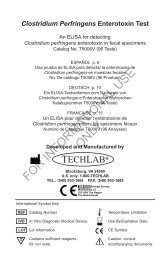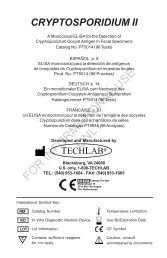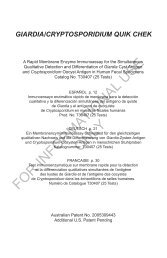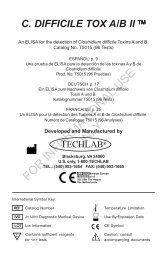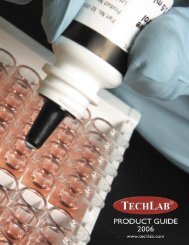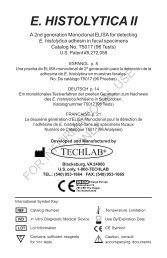ASCA-CHEK - TechLab
ASCA-CHEK - TechLab
ASCA-CHEK - TechLab
Create successful ePaper yourself
Turn your PDF publications into a flip-book with our unique Google optimized e-Paper software.
3<br />
PRECAUTIONS<br />
1. Reagents from different kits should not be mixed. Do not use the kit past the<br />
expiration date.<br />
2. Reagents should be at room temperature before use.<br />
3. Gently mix all reagents before use.<br />
4. Caps and tips are color coded; do not mix!<br />
5. When handling the microassay wells, avoid scratching the bottom of the wells<br />
because this may result in elevated absorbance readings.<br />
6. Hold dropper bottles vertically when dispensing reagent to ensure proper drop<br />
size.<br />
7. Handle specimens and used microassay wells as if capable of transmitting<br />
infectious agents. Wear gloves when doing the test.<br />
8. Reagents contain thimerosal as a preservative and should be handled with normal<br />
laboratory caution.<br />
9. The Stop Solution contains 0.6 N sulfuric acid. Flush with water immediately if<br />
contact occurs.<br />
10. Unused microassay wells must be placed inside the resealable pouch immediately<br />
with the desiccant to protect them from moisture.<br />
11. Perform the washing procedure as directed to avoid high background reactions.<br />
12. Use fecal and serum specimens within 48 hours and 7 days, respectively, of<br />
collection to obtain optimal results. Even though a single freeze-thaw is acceptable,<br />
frozen specimens (-20°C or lower) may lose activity due to multiple freezing<br />
and thawing.<br />
13. Do not freeze the reagents. Store the kit between 2° and 8°C.<br />
14. The Substrate is light sensitive and should be protected from direct sunlight or UV<br />
sources. If the Substrate is exposed to light and develops a color, it must be<br />
discarded.<br />
15. Optimal results are obtained by following the specified test procedure. The<br />
concentrations, incubation conditions, and processing specifications have been<br />
optimized for sensitivity and specificity. Alterations of the specified procedure and/<br />
or test conditions may affect the sensitivity and specificity of the test.<br />
16. The Positive Control contains <strong>ASCA</strong> that is a human derived material. Material has<br />
been tested and found negative for antibody to HIV-1, HIV-2, HCV, and HbsAg. No<br />
known test method can offer complete assurance that infectious agents are<br />
absent. ALL HUMAN SOURCE PRODUCTS SHOULD BE HANDLED AS POTENTIALLY<br />
INFECTIOUS MATERIAL. A procedure for handling biohazards is published in the<br />
CDC/NIH Manual of Biosafety in Microbiology & Biomedical Laboratories.<br />
17. Microbial contamination of reagents may decrease the accuracy of the assay.<br />
Avoid microbial contamination of reagents by using sterile disposable pipettes if<br />
removing aliquots from reagent bottles.<br />
FOR INFORMATIONAL USE<br />
ONLY<br />
PRELIMINARY PREPARATIONS<br />
1. All reagents must be at room temperature prior to use in the assay.<br />
2. Prepare 1X Wash Solution. The Wash Solution is supplied as a 20X concentrate<br />
(a precipitate may be noticed and is acceptable). Dilute to a total volume of 1<br />
liter by adding 50 mL of the concentrate to 950 mL of deionized water. Label the<br />
bottle. Store any unused 1X Wash Solution between 2° and 8°C.<br />
3. Prepare 1X Diluent. The Diluent is supplied as a 10X concentrate (a precipitate<br />
may be noticed and is acceptable). Dilute to a total volume of 400 mL by adding 40<br />
mL of the concentrate to 360 mL of deionized water. Label the bottle. Store any<br />
unused 1X Diluent between 2° and 8°C.<br />
4. Microassay Plate preparation. Each strip contains 8 microassay wells coated<br />
with antigens of Saccharomyces cerevisiae. Each specimen or control will require<br />
one of these coated wells. Avoid contact with the bottom of the wells because this<br />
is the optical window for ELISA readers. Microassay wells not used must be<br />
immediately returned to the plastic bag and carefully resealed with desiccant.



